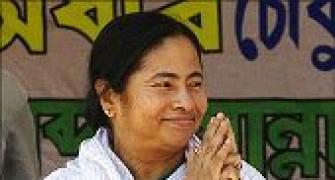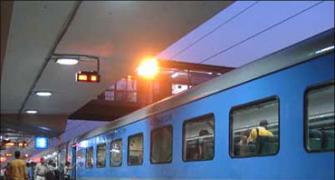 We do not expect hike in passenger fares, but select commodity freight can be hiked while railways procurement of wagons can go up.
We do not expect hike in passenger fares, but select commodity freight can be hiked while railways procurement of wagons can go up.
Indian Railways, which manages the world's third largest rail network under single management, is the backbone of country moving people/cargo from one place to other with-in the country.
Revenue from movement of freight and passengers are the major revenue provider for Indian railways with the former accounting for approximately 67-70 per cent of the revenue and balance 30-33 per cent coming from passenger traffic.
Because of populist measures of incumbent governments the passenger tariff has not seen a rise for long but the railways has managed to augment its freight revenues through increase in wagon load, faster turnaround time and a more rational pricing policy.
The approximate earnings of IR for the 10-month period between April-Jan 2010 were higher by 8.6 per cent to Rs 70501.65 crore (Rs 705.01 billion) with that of revenue from freight earnings up by 8.5 per cent (to Rs 47763.29 crore or Rs 477.63 billion) and that of passenger earnings grew by 7.4 per cent (to Rs 19393.26 crore or Rs 193.93 billion).
The higher single digit growth in passenger traffic despite no rise in passenger fares in last 12 months can be attributed to higher passenger traffic during the period with number of passenger booking increase by 5 per cent during the period.
For the first 10 months, the commodity cargo has increased by 7.29 per cent to 730.96 million tones.
With much improved economy and growth in industrial output the railway seeks higher freight target for FY 2009-10 to 900 million tones from 882 million tones estimated in July 2009.
The Vision 2020 document of Indian Railways which was unveiled by the current incumbent railway minister, envisages expansion of the rail network to connect un-served areas at a very ambitious rate of 2500 KM per annum (for next 10 years), doubling/quadrupling and electrification of key routes, completion of gauge conversion, and raising of speed for both passenger and freight traffic.
Prevention & elimination of accidents and equipment failures, technological up-gradation & modernisation as well as elimination of shortages of any kind in freight and passenger service are some of the other major goals set in the Vision document.
Towards this Indian Railways requires Rs 1,400,000 crore (Rs 14,000 billion) as per the internal assessment over the next 10 years. Railways propose to meet this huge funds requirement from internal resource generation and various extra-budgetary resources (including PPP and support of state governments) as well as budgetary support.
However, given the populist pressures how the Indian railways will rise its internal cash generation as well as hard decision of divestment of its stake in some of the public sector undertaking under its management has to be seen.
Industry expectations
PHD Chamber of Commerce and Industry
PHD Chambers highlighted the key measures urgently required by the Government of Indian to make railways a premier logistic and passenger solutions provider in its memorandum presented to Ministry of Railways, that are:
1.Ministry/ IR should focus only on core services such as the operation and maintenance of Railway transport, rolling stock, freight management, etc. The non-core activities such as canteen, refreshment, pantry services and the like should entirely be run on PPP basis through corporate framework. Consequently, the resources of the Railways would be effectively harnessed for the core activities, leaving the non-core activities to those in the private sector having the requisite specialization.
2.Railways should become price competitive, provide economical rates, adequately address capacity constraints on the high density corridors and the connecting network, improve terminal management, upgrade rolling stocks and more importantly move goods with speed and safety. These measures will attract more freight to Railways.
3.Poor connectivity to ports and warehouses are the bottlenecks, diverting cargos especially exports and import cargos to road. Railways need to address this on priority basis.
4. Railway ministry should develop a policy statement communicating Railways' PPP vision and the road-map for the same. Unless Railways improves its attractiveness the private investment will be elusive leading to shortage of funds in meeting the vision 2020 goals.
5. Railways should identify unencumbered lands under its ownership both vacant and non vacant lands and also announce projects (e.g. cold storage, rural handicraft workshop, etc) to which that are suitable. Based on the above-stated findings, invitation from the private sector could be invited for development of the projects on the identified site on revenue sharing basis on BOOT model or its variants. The route for PPP could be either through press advertisement or on the basis of Swiss Challenge concept.
6. Multifunctional complexes should be developed under PPP mode at major city stations. This will help in reducing the movement of persons from railways stations and the office / malls / picture halls / eateries, etc. and will generate additional revenue for the Railways.
7. Existing corporations of the Railways such as IRCTC, IRCON, RITES and other similar entities should be considered to be placed on PPP route through disinvestment of share holdings and/or injection of fresh capital or a combination of both.
8. The lease rental for Railways land, which is the basis for most PPP projects, should be more economical and attractive to the private investors.
9. The PPP Mode also needs to be considered afresh for developing high speed passenger corridors, multi-modal logistics parks, development of world class stations.
10. The Indian Railways should introduce innovative train services, to attract customers to shift from road to rail.
11. In order to enhance the freight carrying capacity, the Ministry could consider introduction of double-decker (2-tier rakes) goods' trains to double the freight capacity. The problem of the low level overhead wires should be appropriately solved for its successful implementation. It is also suggested that equal if not greater priority in movement be given to the goods trains like that given to some passenger trains such as the Rajdhani, Shatabdi, etc.
12. IR should refrain from frequent increase in haulage charges to give a boost to the container rail sector that was opened to private investors about three years ago but has met with a limited success.
13. It is has also been requested that the basis of calculation of wharfage and demurrage charge be modified from hourly to daily basis. The permissible free time should be extended to at least two / three days and the free time be considered from the opening time of the office.
14. The Wagon Investment Scheme (WIS) and the Terminal Incentive cum Engine-on-Load Scheme (TIELS) need to be revisited to give a fillip to the PPP.
15. The work on the Dedicated Freight Corridor (DFC) needs to be rejuvenated/ accelerated.
16. Improvement in passenger amenities by the railways should be an important objective to increase the passenger traffic. Hygiene and cleanliness should be an important activity for day to day monitoring. Platforms should be constructed with smooth and durable materials, so that these can be kept clean with minimum efforts and last long. This will also give a boost to domestic and foreign tourists traveling by train.
17. Investments and plans announced for the development should be implemented in time bound manner and milestones are specified for completion of the projects.
The wish-list of D P Agarwal, Vice Chairman and Managing Director of Transport Corporation of India as far as Railway Budget 2010-11 is:
1. As the existing rail network is not adequate as compared to the burgeoning rail freight business, it should be expanded and dedicated freight lines should be upgraded/ accelerated to avoid congestion on the operative routes. The number of existing rakes, wagons and racks should also be substantially increased to cater to the increasing demand.
2. To commit timely delivery of goods, Railways should run the freight trains like passenger trains i.e. time-scheduled freight trains in all-major routes to ensure better customer service
3. Loading and unloading times must be increased for full wagons. Improve handling at terminals (pay and use system can be incorporated). The handling work at terminals is done by the pre-approved labour force, who work at their own pace and charge high rates. Allowing outside labour will reduce the time spent on loading/ unloading of the rakes leading to a quicker turnaround time
4. The rail ministry should follow a PPP model wherein building the network, tracks, terminals, haulage points etc. would be undertaken by the railways (as in the case of Roads) while the running of freight trains would be the responsibility of private players
5. The Arbitrator of disputes (pilferage, damage, service efficiency etc) should be moved to an independent authority. Any loss or claim against the railways is referred to the Arbitrator for settlement. There should be a third party (independent party) to look into these matters
As proposed by Indian Railways earlier, it should work towards the development of multi-modal logistics park along the eastern and western freight corridors much earlier than the freight corridors are established. This will ensure road & rail traffic flows to get oriented by the time the freight corridors are operational.
Analyst expectations
With elections approaching in key states the Railway Budget 2010-11 is not expected to increase the passenger fares. Moreover the states that are expected to see elections next year such as West Bengal, Tamil Nadu and Kerala could see more new projects/ trains announced in the budget.
We do not expect an across the board hike in freight tariff given the current high inflation scenario, but the Railways could resort to selective commodity wise tariff hike. Most likely the bulk commodity cargos such as iron ore, coal, cement etc are likely to see increase in freight tariff. Further with the haulage charges for container freight has been recently hiked in Jan 2010 is not likely to see one more hike in the budget.
Stocks to watch
Kalindee Rail Nirman, Texmaco, Titagarh Wagons, BEML, Stone India, Hind Rectifiers
Outlook
While the huge investment under pipeline either under the Dedicated Freight Corridor project or modernization and expansion of current rail networks by IR are to generate enough orders for the construction and equipment suppliers.
Further the high single digit growth in goods volume as well as passenger traffic, IR railways is expected to increase the rolling stock procurement auguring well for rolling stock manufacturers like BEML, Texmaco, Titagarh Wagons etc.
Similarly some clarity on PPP policy will do well for private sector developers who are interested in taking up railway project development.
If the railway budget refrains from hiking the passenger tariff and prefers selective hike in goods tariff, it will not expected to be have any major negatives for the industry. Overall the Railway budget is expected to be neutral.








